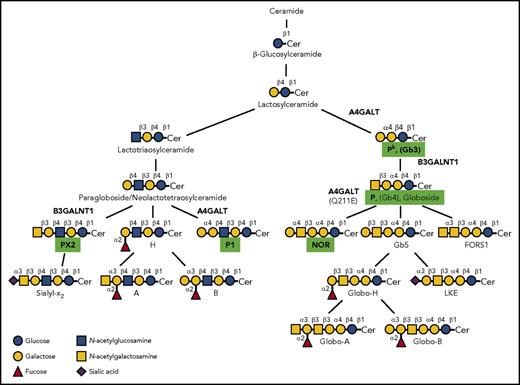In this issue of Blood, Westman et al demonstrate that expression of the P1 blood group antigen is regulated by the transcription factor RUNX1, which binds to an intronic region of A4GALT present in P1 alleles but not P2 alleles.1
Schematic representation showing the synthesis pathways of selected glycosphingolipids. Structures relevant to this commentary are marked with bold text and highlighted in green. The names of the glycosyltransferases involved in the formation of the relevant structures are A4GALT (α1,4-galactosyltransferase) and B3GALNT1 (β-1,3-N-acetylgalactosaminyltransferase1). Cer, ceramide. Adapted from Westman et al.8
Schematic representation showing the synthesis pathways of selected glycosphingolipids. Structures relevant to this commentary are marked with bold text and highlighted in green. The names of the glycosyltransferases involved in the formation of the relevant structures are A4GALT (α1,4-galactosyltransferase) and B3GALNT1 (β-1,3-N-acetylgalactosaminyltransferase1). Cer, ceramide. Adapted from Westman et al.8
The P1PK and GLOB blood group systems are clinically important, both in immunohematology and in their broader disease associations. It has taken many years to sort out the relationships between the different antigens of these systems, and this, along with the many historical changes in their nomenclature, has increased the acknowledged complexity of these systems. It is known that the key P1PK/GLOB antigens present on red blood cells (RBCs) are P1, Pk, and P, and the antibodies produced when these antigens are missing are anti-P1, anti-Pk, and anti-P (or if all are missing, anti-PP1Pk, also known as anti-Tja). The two common P1PK/GLOB phenotypes are P1 (20% to 90% prevalence; P1, Pk, and P antigens on RBCs and no serum antibodies) and P2 (10% to 80% prevalence; Pk and P antigens on RBCs and sometimes anti-P1 in the serum). The three rare phenotypes are p (no P1PK/GLOB antigens on RBCs and anti-PP1Pk in serum), P1k (P1 and Pk antigens on RBCs and anti-P in serum), and P2k (Pk antigen on RBCs and anti-P, anti-P1, and sometimes also anti-PX2 in serum).2
The P1PK/GLOB antigens are present on RBCs, have wide tissue distributions, and can act as host receptors for various pathogens and toxins. Anti-P1 is usually a weak, cold-reactive antibody and is rarely implicated in hemolytic transfusion reactions or hemolytic disease of the fetus and newborn; however, anti-PP1Pk antibodies can cause hemolytic transfusion reactions, and a higher frequency of miscarriage is seen in women with the rare phenotypes p, P1k, and P2k.2 This effect may result from the low expression of P1, Pk, and P in the fetus and newborn relative to the high expression of these antigens in the placenta.3
Disease associations of the P1PK/GLOB antigens include the recognition by proteins of pathogenic Escherichia coli in human epithelial cells of the urinary tract, which can cause chronic urinary tract infections or hemolytic uremic syndrome.2,4 P1 and Pk also form receptors for Streptococcus suis, a zoonotic bacterium that can cause bacterial meningitis,5 and Pseudomonas aeruginosa, an opportunistic human pathogen.2 Pk (and also P1) inhibits the entry of HIV into peripheral blood mononuclear cells in vitro.2 Pk forms a receptor for Shiga toxin which can cause dysentery,6 and P antigen forms a receptor for parvovirus B19, which may cause fetal anemia and can result in paroxysmal cold hemoglobinuria in children after a viral infection.7
The P1PK blood group system currently includes the P1, Pk, and NOR antigens, whereas the GLOB blood group system contains P and PX2.8 The antigens in the P1PK/GLOB blood group systems are carried on glycosphingolipids. A schematic representation of the biosynthetic pathways of selected glycosphingolipids is shown in the figure and highlights two key enzymes, α1,4-galactosyltransferase (A4GALT) and β1,3-N-acetylgalactosaminyltransferase (B3GALNT1), involved in the synthesis of P1, Pk, NOR, P, and PX2. Pk is formed directly from lactosylceramide whereas P1 is formed from lactosylceramide in a 2-step process via paragloboside. The formation of both P1 and Pk involves A4GALT. The NOR antigen is synthesized by a variant A4GALT enzyme with a single nucleotide substitution, Gln211Glu.8 Most Pk antigen is converted by B3GALNT1 into the P antigen, which explains why Pk was once thought to be a low-prevalence antigen. Most RBCs express low levels of Pk antigen, but RBCs from P1 individuals express more Pk antigen than those from P2 individuals. Full Pk antigen expression occurs when there is a mutation in B3GALNT1 and Pk is not converted to P.
Knockout mutations in A4GALT result in the p phenotype, and the reason why p individuals lack not only Pk and P expression but also P1 was a long standing enigma. In 2011, it was shown that A4GALT synthesizes both the P1 and Pk antigens and that a polymorphism (rs8138197) in a new exon in this gene predicts the P1 and P2 phenotypes2 ; however, the mechanism of this differential expression is yet to be determined.
Individuals with the In(Lu) phenotype express lower amounts of P1 antigen, and In(Lu) results from heterozygous mutations in the KLF1 gene.9 This, and the fact that P1 individuals have higher levels of A4GALT transcripts than P2 individuals, suggested that expression of Pk and P1 may depend on binding of a transcription factor. Westman et al identify 3 potential transcription factor binding sites (KLF1, RUNX1, and EGR1) overlapping a single nucleotide polymorphism (rs5751348) in linkage disequilibrium with rs8138197.10 By using an electrophoretic mobility-shift assay, P1 or P2 oligonucleotide probes, and mass spectrometry, the authors identify RUNX1 as the transcription factor critical to P1 expression. They further show that knockdown of RUNX1 (but not KLF1) decreases A4GALT transcription, thus confirming that RUNX1 regulates the expression of A4GALT. Thus, a mechanism underlying the expression of P1 has been uncovered, and this means genetic typing to predict P1 expression should be directed at rs5751348.
Conflict-of-interest disclosure: The author declares no competing financial interests.


This feature is available to Subscribers Only
Sign In or Create an Account Close Modal